The first of March dawned dull and grey, with low clouds obscuring the hills around the city. Despite spending so long in Ushuaia I had lots of last minute preparations to complete and, heading into town, I caught my first glimpse of the M/V Ushuaia lying in dock having arrived in the small hours of the morning.
As the day progressed the weather improved and by the time I boarded there was brilliant sunshine and a cloudless sky. I was shown to my tiny shared cabin well below decks – the modern equivalent of being in steerage – but all that anyone wanted to do was get outside in the sun, and soon our group were lining the rails to watch the gangway be stowed and moorings untied.
The Ushuaia in dock
The Ushuaia is a 30 year old American ship that started life as an oceanographic survey vessel and Russian sub follower. It is only 85m long and 15m across, and takes 66 passengers plus 30 crew. It has an ice strengthened hull and is, in reality, a supply and research vessel that has realized that Antarctic tourism pays a lot better. Our crew were an especially talented group – we were lucky to have on board a very experienced tour leader with a lot of friends in the region and one of the best ice pilots there is - former commander of the Argentine Navy Antarctic division.
We departed a couple of hours later and headed east down the Beagle Channel, in a flat calm. The Beagle, so called after the being explored by the same boat that carried Darwin, divides Chile from Argentina south of Tierra del Fuego. The channel leads into the Drake Passage after about 7 hours of steaming, the Drake being one of the most ferocious stretches of water in the world. It is the confluence of the Antarctic, Pacific and Atlantic oceans, and the huge swells that can be generated have made Cape Horn a place of fear for mariners over hundreds of years.
The Beagle Channel, looking west
The Beagle Channel, looking east
As the sun set we had an excellent meal – one of many on board – and had our first Antarctic educational film. As night fell we were all called to the bow to watch a pod of dolphins that had begun playing in front of the ship. In the dark there was a stunning phosphoresence that made both dolphins and ship glow a pale green – there was nothing else on earth like watching the show that was created, as the dolphins wove back and foerth leaving shining trails in their wake.
The next morning we awoke to a steady heeling motion, telling us that we were well into the Drake Passage. On the bridge – permanently open to us to satisfy our curiosity – we were informed that there was a 1-2m swell and that this, by normal standards, was a picnic. The 15° tilt to either side had confined a lot of people to their beds however, and breakfast was a poor show. One of the many good things about the Ushuaia was the openess and friendliness of the crew - the only things banned were whistling on the bridge and mentioning the Titanic. The captain, when asked by one tourist how far to one side the boat could roll in the waves, answered with a straight face "180 degrees" - much to the amusment of the rest of the crew.
There is 1000km of open water - the Drake Passage - between Cape Horn and the South Shetland Islands, the island group that lies a little off the west coast of the Antarctic peninsula. This distance was covered in 2 days, during which there were a series of educational lectures on the flora and fauna of Antarctica, run by the on-board biologists. Gradually a few more people appeared above decks, although there were a lot of pale faces and empty spaces at most meals. We were assured that this was the best crossing so far this season - something the sickest in the group did not appreciate.
During late morning of the 3rd we sighted our first iceberg, and shortly after several were visible on the horizon. It caused a wave of excitement and the bridge was full as we crusied by the first one, floating like a huge cathedral on the water. The icebergs were all formed by “calving” glaciers – very different to the huge flat bergs (some the size of countries) created by disintegration of ice shelves.
Iceberg!
By afternoon we had sighted King George Island, in the South Shetlands, and we made our first landing by Zodiac at Bellinghausen and Frei stations, run by Russia and Chile respectively.
Zodiac Landing
These stations were not the Antarctic I was imagining – cold, glaciated, but not the mass of ice I had expected. The bases in these places appear to be very much a flag-flying exercise so that territorial claims, currently forgotten about under the Antarctic Treaty, remain valid when the treaty comes to be renegotiated in 2041. We were given a tour of both bases – I found the post office, bank, church, school, souvenir shop and gym all a little depressing, truth be told.
Frei Station
Russian Orthodox Church
The next morning we made two landings, the first at Halfmoon Island, where an Argentine base shared the land with a Chinstrap penguin rookery and a lot of fur seals. At this time of year penguin chicks are becoming quite large and are gaining their adult plumage; we were able to get really close but I felt uncomfortable about walking through the rookery in such close proximity – a sure source of stress for the penguins.
Chinstrap pengiuns
Chinstrap chick
The fur seals showed their stress at our presence in a different way – they become quite agressive and growl if approached to close. Part of this is because they were all juvenile males, excluded from the breeding colonies at this time of year. They regularly fight each other and it can make spectacular viewing.
Fur seals fighting
Whilst exploring I also had the pleasure of being dive bombed by some Giant Skuas – these birds can become very forceful when protecting their nests and can draw blood after several attacks.
In the afternoon we made a landing a Whalers Bay, Deception Island. This island is a sunken caldera of a still active volcano, and the beach is hot all around the shore. The Bay was initally a whaling station, then abandoned but reopened by the British in World War II as part of covert operation to protect the Antarctic from Hitler’s claims.
View over Whaler’s Bay
Fur seal, Whalers Bay
The base was abandoned after an eruption in 1971 but there are still fascinating remains to be seen amongst the fur seals, the odd Chinstrap and the occasional Gentoo penguin. After exploring the bay the braver members of our party opted for a quick Antarctic swim, followed by a dip in a hot pool, dug out by the crew, on the shore.
Back to the pool, double time!
As the afternoon drew to a close we set sail for the mainland Antarctic peninsula, some 12 hours away. We first sighted land some hours later – a seemingly impossible huge wall of white that stretched as far as the eye could see across the horizon. It took my breath away – there was something unreal about the sight, and for a while there were a group of us spellbound at the bow.
The following morning dawned bright and sunny – this was not the Antarctic weather we had been lead to expect. We made our first landing at Danco Island, another former British base (now removed), and currently home to several thousand Gentoo penguins, fur seals, snowy sheathbills and a few skuas. Around the bay we could see several humpback whales, resting in the surface waters, gently blowing out every few minutes. We climbed to the top of the icecapped island in the perfect still and quiet that had descended on the bay after we arrived. There was something about the silence that seemed to drown out even other peoples voices, and the realization of where we were was driven home to many in silent contempation on top of that snowy hill.
Gentoos chicks, Danco Island
On top of Danco Island
Reluctantly returning to the Ushuaia, we had the good fortune to see a huge leopard seal – top of the food chain around these parts – lazing on a small berg close to the boat. At around 3-4 metres long and several hundred kilos, we made a rapid exit when it made to get in the water close to us.
Leopard Seal
In the afternoon we made our first landing on the white continent proper, at Paradise Bay. Another Argentine base (abandoned), another Gentoo colony, and excellent views over what the first Norwegian whalers here had rightly called Paradise. It’s pretty easy to get blasé about the sights seen – especially the penguins – but somehow the surroundings never lost their charm. The smell of guano was certainley one that seemed to linger everywhere.
View from Paradise Bay
The afternoon was rounded off by a Zodiac cruise around the bay, to see the Blue Eyed Shag colonies on the cliffs around and catch a closer glimpse of small icebergs that had calved off the glacier in the bay. We also caught sight of a crabeater seal (main diet – fish) with a large injury on its side, almost certainly caused by a leopard seal.
Bergy-bit in Paradise Bay
The morning of the 6th provided us with weather slightly more in keeping with the Antarctic. There was a heavy swell that prevented us landing at Orne Island, home to a Chinstrap rookery, and instead we landed nearby in the more sheltered waters of Cuverville Island. As we departed from the Ushuaia in the Zodiac a couple of humpbacks surfaced close by, and we spent an excellent (if freezing) half hour following their slow progress across the bay. On the island there was a Gentoo rookery with very friendly and inquisitive chicks – my hands and jacket were thoroughly pecked by a couple of curious fluffy creatures. It’s pretty easy to lose interest in the smell of a penguin rookery quickly, but the young were as interested in us as we were them. On this island there is also one of only 2 species of flowering plant found on in the Antarctic region – and it looked very much like grass from a lawn.A curious Gentoo chick tries kate's mittens
More Gentoo chicks
That afternoon we cruised into Andvord Bay and made a landing at Neko Harbour – our second landing on mainland Antarctica. Here there is an extremely active glacier surrounding the harbour, and it regularly calves huge chunks of ice into the sea. In the bay there was a lot of ice in the sea, and unusually it was of 3 types – glacial ice, calved from glaciers into the sea; sea ice forming on the surface, and finally pack ice that had broken up further south. There was a Gentoo rookery, a large number of fur seals, and two Minke whales cruised into the harbour as we were on land. We witnessed on section of glacier calving – the tremendous noise and waves generated are not done justice by my poor photos!
Glacier calving
As we left Neko it began snowing and the cloud dropped low. There was no wind and the image of an eerie Antarctic that I had imagined took shape. We left early due to increasing amounts of ice and the fear that we would not be able to get back to the Ushuaia in the Zodiacs if we stayed ashore for longer.
That evening, as was the norm on the boat, we had an educational film after dinner and afterwards most people turned in. Around midnight a small group of 10-15 were still up, and one of the on-board biologists appeared with his guitar to start the almost nightly singsong that everyone enjoyed. There was light in the sky when we finally got to bed.
The Ushuaia in Neko Harbour
The following morning we attempted to pass through the Lemaire channel, a stunning 7 mile long, mile wide channel through rocky, icecapped scenery. The view that morning was exceptional – a pale golden glow lit the sky and earth in a kind of heavenly light, and in the dead calm we made our way through forming pack ice and remnants of ice shelf. Almost the entire boat turned out to witness the awe-insiring spectacle, the Ushuaia crunching through small sheets of pack and knocking small bergs out the way. After an hour it became clear we were unable to pass through due to the quantities of ice, and with sadness the boat turned around to head to the Neumayer Channel, an alternative route that took us through a wider and more ice free channel.
Morning light, Lemaire Channel - part 1
Morning light, Lemaire Channel - part 2
By this point it was becoming clear that the usual cruise routes, further to the south, were impassable due to ice. Part of this is due to the break up of an ice shelf further south, but winter also appears to be coming 2 weeks early this year,and the ice is forming fast. We had to adapt our route to remain further in the north, and visit some areas more than once.
Morning light, Lemaire Channel at our further point of entry
The Neumayer Channel was beautiful in a different way. Huge glaciers descend from the mountains of Anvers Island into the sea, contrasting with the rocky moutains that surround the Lemaire. The highlight of the morning was coming across 2 humpback whales that were only too happy to play in front of the boat for around an hour – lots of fin slapping, tail slapping, and one breached directly in front of the boat.
Humpbacks playing
In the afternoon we made the landing at Orne Island that we had failed to do the previous day. Giant skuas added fun by dive bombing most people in the group, and the chicks of both the Gentoos and the Chinstraps proved irresistable as ever. The sun was shining brightly again, and it was hard to believe again we were in Antarctica. We took a group photo and the realisation dawned that soon our cruise would be coming to an end.
Blue Eyed Shag, Orne Island
The 8th was our last day in Antarctica. The forecast for the return crossing of the Drake promised a fierce head wind that would slow us down considerably, making leaving slighlty early a necessity. Because of this, we made only one landing in the morning at Port Lockroy, British Antarctic Territory. As with many other places, the skeletons of whale bones from kills past littered the beaches, whilst Gentoo chicks huddled under the bones waiting for their next feed.
Gentoo chick amongst whale bones
Port Lockroy is a former British base that was also established in the Second World War, then abandoned in 1962. It underwent a huge facelift and cleanup in 1996 and is now a living museum, where 3 volunteers live for the winter months in 1950 conditions – no electricity, no radio, precious little to cook. After the base was abandoned a rookery of chinstraps took over the island, and remained when the island was "restored" up 9 years ago. Nowadays it is a popular tourist spot, with post office, souvenir shop and an excellent museum. Once again, the highlight was being pecked by a young, curious Gentoo chick.
Please can I peck you?
All too soon we had to board the Zodiacs to get back to the Ushuaia, to start back across the Drake for her namesake city. As we cruised back up the Neumayer Channel and then between Anvers and Brabant Islands, there was an unspoken sadness on board, and more than a little anticipation about what the Drake might throw at us. A hardcore Brtish contingent sat out on the front of the boat, in the freezing cold, watching whales, icebergs and mountains of ice, all disappearing slowly in the distance. At around 4pm we finally entered back into the Drake and headed back for home.
Leaving Antarctica
The return Drake Passage was a little more like it's reputation - 25 knot wind, 2-3 metre swell, horizontal driving snow. It was still childs play by normal standards, but enough to put over half the boat to bed having lost their sea legs. Life on board was quiet for 48 hours, although many of the late night usual suspects seemed not to suffer from the steady rocking. The more experienced seafarers on board agreed that the Ushuaia, whilst being a nice boat, wallowed like a pig and had a very strange pitching motion.
On the evening of the 10th we pulled back into the Beagle Channel and anchored for the Captains evening dinner and party. There were a few well received sketches (it has become apparent that I can do a good David Attenborough impression) followed by dancing until the small hours. At some point we weighed anchor and started for Ushuaia again, and when we emerged bleary eyed in the morning we were alongside, waiting to disembark.
In a very sad way the voyage petered out - people drifted away in small groups, saying incomplete goodbyes. The group had been exceptionally fun, and able to create it's own entertainment and mischief on most nights - a range of 21 nationalities, and ages ranging from 22 to 82.
Things move on though, and tomorrow I'm going back to Chile to Puerto Natales, with the aim of reaching Torres del Paine in a few days to go trekking.
So what about Antarctica? $2500 for 4 days of steaming in open water, only 5 and a half days there, plus seasickness and small cabins... was it worth it?
The simple answer is yes. It's a cliche, but words can't do it justice. The sheer size, beauty and desolation brings with it a kind of blanket of serenity that makes you want to sing, write poetry and gaze in silence all at once. When I think about it, a shiver runs down my spine, and I want to go back.
Friday, March 11, 2005
South with M/V Ushuaia - and the Antarctic
Subscribe to:
Post Comments (Atom)









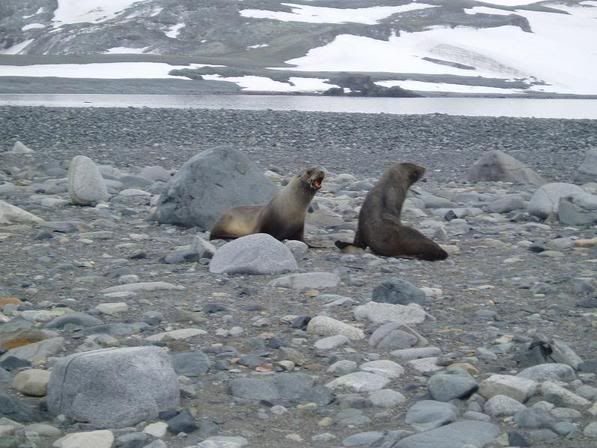


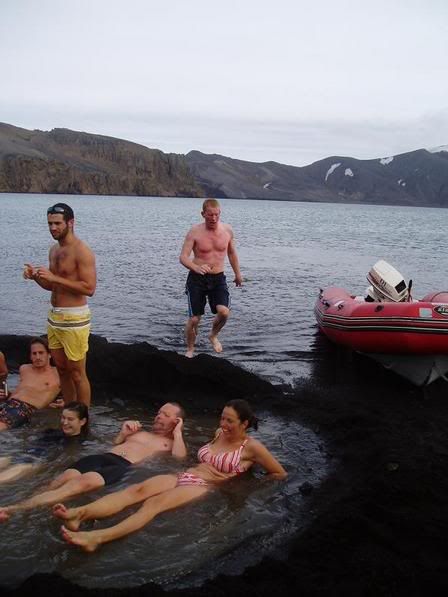
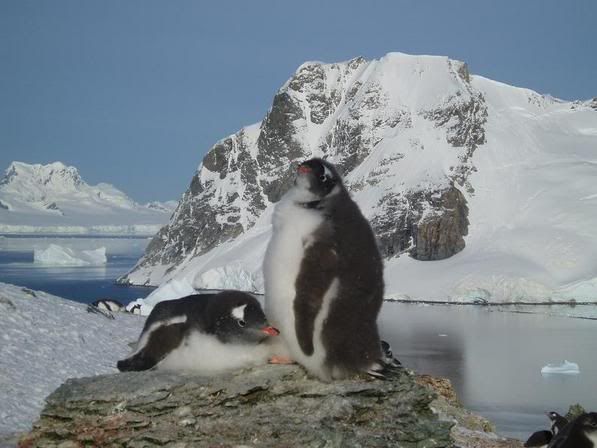










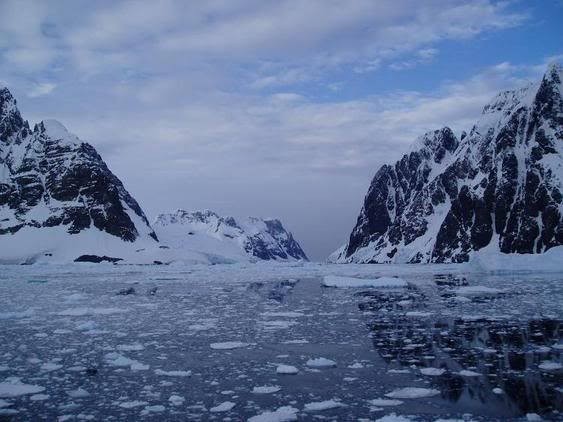


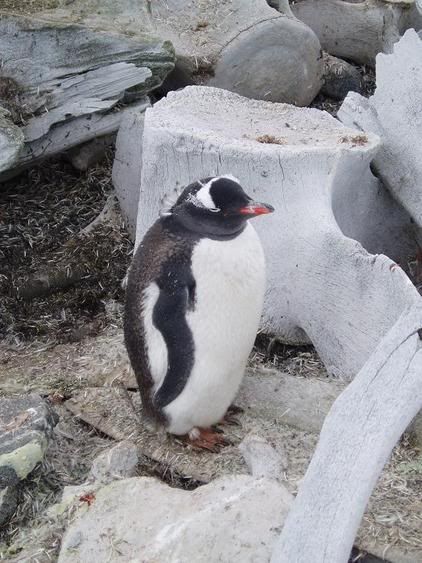

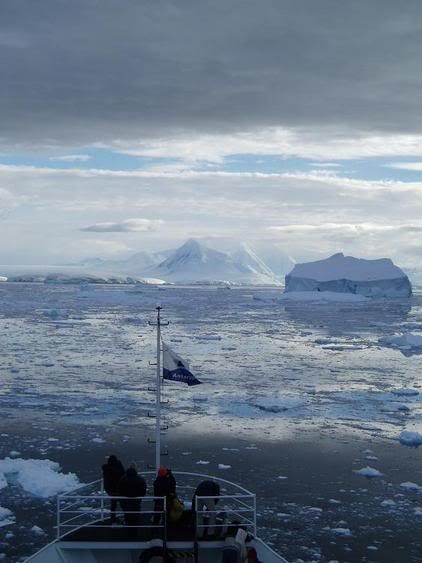


5 comments:
Pete, We are at the library and have enjoyed a tour of Antarctica and seen all the lovely pictures of the places you've visited in your travels. Looking forward to seeing the next lot of pictures!!!
Much love, Granny and A Joy
Now I am sure what I want for my 60th birthday Pete-I hope Dad likes the idea too!. It all looks breathtakingly wonderful but we might not be so lucky with the wather as you.I had google searched after you went and was so suprised that it had shown me that very boat and pictures of the swim/warm pool etc!
Still lovin' it Pete. Quite a few peeps at the office enjoying the photos too - v. v. good! Cheers, your bro Dave.
Awesome Antarctica!Your father is now going to get some ear-bashing as Mum has DECIDED on her 60th pressie!Personally I'll stick to warmer climes esp as I'm sea-sick!Just returned from meet-up with N&H in KL thought I'd blog you as I know how much they value comments from home on theirs.They agreed with you on the Israeli pack routine!After a week together they flew to Oz and we to Langkawi-hotel on David's recomm-bliss apart from the Tsunami alert!I'm expecting an Ode to Antarctica,you always were good at poetry and should certainly be inspired judging by the photos!All the best,Chris Fisher.
I'm going there in July. I hope I can have such a good time as u had.
Regards.
Post a Comment